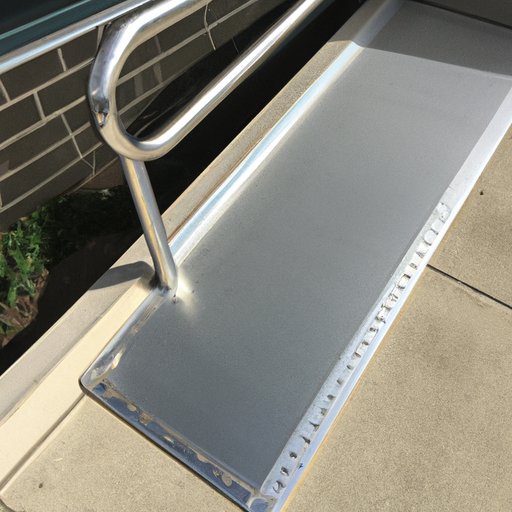Introduction
Aluminum handicap ramps are an important part of making public spaces and private residences accessible for those with disabilities or mobility issues. They provide a safe and reliable way for individuals to traverse steps or other obstacles that would otherwise be difficult or even impossible to navigate. This guide will provide an overview of aluminum handicap ramps, including factors to consider when purchasing one, how to maintain it, and cost considerations for installation. Additionally, some case studies of successful ramp installations will be discussed.

Guide to Purchasing the Right Aluminum Ramp
When it comes to purchasing an aluminum ramp, there are several factors to consider. The size of the ramp should be determined based on the height of the obstacle and the clearance needed for wheelchairs or other mobility devices. The angle of the ramp should also be taken into account, as a steeper angle can make it more difficult to traverse. It is also important to consider the type of surface the ramp will be installed on, as well as the weight capacity of the ramp.
Aluminum ramps can be purchased from a variety of retailers, both online and in-store. It is important to research different options and compare prices before making a purchase. There are various types of aluminum ramps available, such as single-fold ramps, multi-fold ramps, and modular ramps. Each type has its own unique advantages and disadvantages, so it is important to choose the right one for your needs.
In-Depth Look at Aluminum Ramp Design and Construction
When constructing an aluminum ramp, it is important to consider the materials used. Common materials for aluminum ramps include aluminum, steel, wood, and composite. Each material has its own advantages and disadvantages, such as weight capacity, durability, and cost. It is important to research each material and determine which one is best suited for your needs.
When constructing a ramp, safety should be the top priority. All ramps should have a non-slip surface to prevent falls, and all edges should be rounded to avoid sharp corners. Proper drainage should also be taken into account to ensure the ramp is not damaged by water or snow. Additionally, handrails should be installed on both sides of the ramp to provide support and stability.

How to Maintain an Aluminum Ramp
Regular inspection and cleaning of an aluminum ramp is essential to ensure it remains safe and functional. It is important to inspect the ramp on a regular basis for any signs of wear or damage. Any cracks, chips, or other damage should be repaired as soon as possible. Additionally, it is important to keep the ramp free of debris and any other obstructions.
There are a few simple techniques that can be used to maintain an aluminum ramp. Regular sweeping and washing can help keep the ramp free of dirt and debris. Additionally, applying a protective coating of wax or sealant can help protect the ramp from corrosion and other damage caused by weather or wear and tear. Finally, any minor repairs or adjustments should be made as soon as possible to avoid further damage.

Cost Considerations for Installing an Aluminum Handicap Ramp
The cost of installing an aluminum handicap ramp depends on a variety of factors, including the size of the ramp and the materials used. Generally speaking, the larger the ramp and the higher quality materials used, the more expensive the installation will be. Additionally, it is important to factor in any additional costs associated with installation, such as labor and transportation.
It is also possible to find financial assistance to cover the cost of installing an aluminum ramp. Many organizations offer grants or other forms of assistance to help cover the cost of installing an aluminum ramp. Additionally, some states and local governments offer tax incentives for installing handicap ramps.
Accessibility Solutions with Aluminum Handicap Ramps: Case Studies
There are many examples of successful ramp installations across the country. In one example, a school in North Carolina was able to install an aluminum ramp that provided access to the main entrance of the school. The ramp was designed to meet the requirements of the Americans With Disabilities Act and included handrails, a non-slip surface, and proper drainage. The installation was completed in just three days and provided improved access to the school for students and staff.
In another example, a park in California was able to install an aluminum ramp that allowed visitors with disabilities to access the park’s playground. The ramp was designed with a gentle slope and included handrails for added safety. The installation was completed in just two days and provided improved access to the playground for all visitors.
These case studies demonstrate the importance of properly designing and installing an aluminum ramp. By taking into account the user’s needs, the environment, and safety considerations, it is possible to create a successful solution that provides improved access for everyone.
Conclusion
Aluminum handicap ramps are an important part of providing access to public spaces and private residences for those with disabilities or mobility issues. When purchasing an aluminum ramp, it is important to consider the size, angle, surface, and weight capacity. Additionally, it is important to take into account the materials used for construction, as well as safety considerations when constructing a ramp. Regular inspection and cleaning is essential to maintain the ramp, and it is important to factor in the cost of installation when budgeting for a ramp. Finally, case studies of successful ramp installations provide valuable lessons for creating an effective solution.

